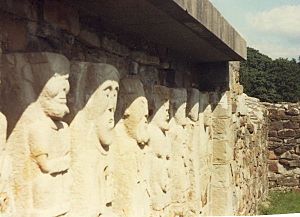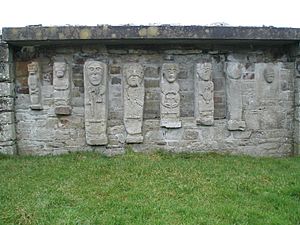White Island, County Fermanagh facts for kids
White Island is a small island located in Lower Lough Erne, which is in County Fermanagh, Northern Ireland. You can find it in Castle Archdale Bay, on the eastern side of Lower Lough Erne.
On the island, there are the old ruins of a church. This church was built where an even older monastic settlement used to be. It still has a beautiful, intact arched doorway built in the Romanesque style. The church and its special carved figures are protected as State Care Historic Monuments. The island is easy to reach by a short ferry ride from the marina at Castle Archdale Country Park, close to Irvinestown.
Contents
What Makes White Island Special?
The Ancient Church and Its Carvings
The ruined church on White Island has a rebuilt Romanesque doorway. Inside the church, on the north side of the south wall, you can see eight amazing stone carvings. These include seven figures and one head. They are built right into the church's stone walls.
Most of these figures are carved wearing long tunics, like church leaders would have worn. All the carvings are made from a type of stone called quartzite. Experts believe they were made between the years 800 and 1000. Later, they were used as building stones when the church was constructed. They were only rediscovered in more recent times.
Helen Hickey, an expert, thinks these carvings might have supported a pulpit or a special chair for preaching in an older wooden church. This is because some figures have sockets on top of their heads. One popular idea is that the figures show a story from the life of Saint Patrick, where he heals a local king.
Exploring the Eight Carved Figures
There are eight figures in total. One figure is not carved at all, which suggests the artists worked on them right there on the island. Another is a frowning face, sometimes called a "mask." Let's look at them from left to right:
- The first figure is thought to be a Sheela na Gig. This is a carving of a grinning, naked female figure with her hands on her thighs. It's hard to tell the gender for sure because of how worn the carving is. These "exhibitionist figures" are common in Ireland. People believed they had magical powers. You often find them above church doorways or windows.
- The second figure sits down and is believed to represent Jesus Christ. It looks a lot like a seated Christ figure found in the famous Book of Kells. This supports the idea that these figures might have held up a lectern or pulpit.
- The third figure is probably an abbot or another high-ranking church official. This figure wears a hood and holds a shepherd's crook and a bell.
- The fourth figure might be King David, pointing to his mouth. This could refer to David's role as a psalmist, someone who writes and sings psalms. This figure also holds a scroll and has a pouch hanging from its belt.
- The fifth and sixth figures were identified by Helen Hickey. The fifth is called 'Christ with Griffins,' and the sixth is 'Christ the warrior with sword & shield.' The sixth figure wears a penannular brooch, a type of pin popular in the 9th or 10th century.
- The seventh figure is blank because it was never carved. The eighth figure is a frowning head.
An old stone with a carved cross was also found built into the wall around the church.
A Glimpse into White Island's Past
History books tell us that Vikings attacked and destroyed the monasteries in Lough Erne in the year 837 AD. This means that the stone carvings you see today might have been lying in ruins for at least 400 years. After that time, a new stone church in the Romanesque style was built, and the carvings were included in its walls.
Images for kids
See also
 In Spanish: Isla White (Irlanda del Norte) para niños
In Spanish: Isla White (Irlanda del Norte) para niños





